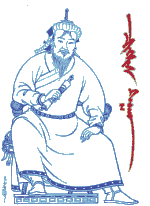|
The Manchu's established three major administrative units and gained
the support and loyalty of some nobility and the numerous monasteries.
The head of Mongolia was the Emperor of the Qing Dynasty, who ruled
all of Manchuria and China as well. Three Manchurian ministries
were established in three major administrative cities - Hovd (Khovd),
Ih Huree (present day Ulaanbaatar, also known by its Russian name,
Urga) and Uliastai. These three Ministries were strategically positioned
in the north, the center, and the west in order to facilitate the
rule of six territorial divisions that existed as kingdoms before
the Manchu subjugation. The Ministries were usually ruled by the
Manchu's, but were staffed with both Mongolian and Manchu officials.
The Hovd Ministry in the west ruled Dorvod and Tsetsen Khan Provinces;
the Ih Huree Ministry ruled the capital and the Central and Eastern
Provinces of Tusheet Khaan and Zasagt Khan; the Uliastai Ministry
ruled the Midwestern provinces of Sain Noyon Khan and Khovsgol and
Uriankhai districts in the North.
|




